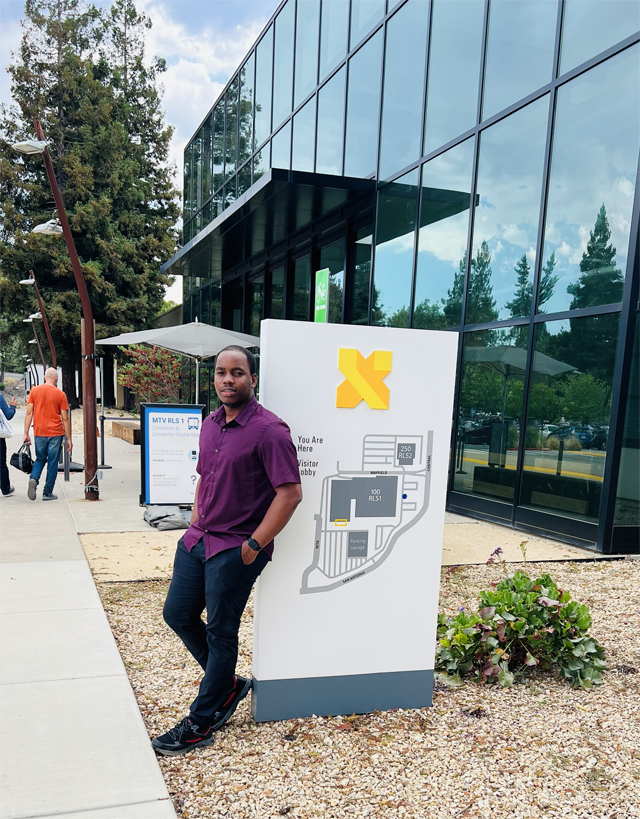30 November 2022–So far, the career of Joses Omojola has moved from water to oil to salt.
His first interest, in hydrogeology, came about in high school after he watched his first water borehole being drilled. “A geologist came over to me, explaining about the different sediments they were bringing out, and explaining to me what each of them meant,” he recalled. As an undergraduate at the University of Lagos, Omojola studied geology and wrote his thesis about aquifer occurrence in southwestern Nigeria.
After graduation, he worked for several petroleum companies as a seismic interpreter and modeler, learning the field of hydrocarbon exploration and production, until a downturn in oil prices convinced him to look at other ways to work in seismology.
 Today, he is finishing his master’s degree in the geology and geophysics department at Louisiana State University before transferring to the University of Arizona in the fall of 2023. His research involves ways to monitor and determine the seismic integrity of underground salt dome caverns at the Sorrento site in southern Louisiana. The hazards posed by salt dome caverns, which act as petroleum traps, were brought into sharp relief in the state with the 2012 Bayou Corne sinkhole disaster. Omojola’s advisor at LSU was Associate Professor Patricia Persaud, who he credited with having a significant impact on his work. He intends to continue working with her during his Ph.D. at UA.
Today, he is finishing his master’s degree in the geology and geophysics department at Louisiana State University before transferring to the University of Arizona in the fall of 2023. His research involves ways to monitor and determine the seismic integrity of underground salt dome caverns at the Sorrento site in southern Louisiana. The hazards posed by salt dome caverns, which act as petroleum traps, were brought into sharp relief in the state with the 2012 Bayou Corne sinkhole disaster. Omojola’s advisor at LSU was Associate Professor Patricia Persaud, who he credited with having a significant impact on his work. He intends to continue working with her during his Ph.D. at UA.
Omojola is using a dense network of geophones to identify hundreds of microearthquakes at the salt domes, using these data to reconstruct an image of the caverns and monitor their structural integrity over time.
The passive seismic monitoring is different from the techniques used in petroleum exploration, he noted, which often uses active source methods to image underground structures. “At the salt-sediment boundary, we have this chaotic reflection within the salt, and you really can’t image within the salt. The images come out really blurry,” Omojola explained.
Using data from microearthquakes works better, he said, “because their waves are traveling out of the salt. They are less distorted than trying to send a wave into the salt dome and waiting for the reflection back.”
To detect these small earthquakes, Omojola and his colleagues have turned to machine learning. They began with large training datasets, most notably the STanford EArthquake Dataset (STEAD). They then whittled the database down to signals from earthquakes magnitude 3 and smaller and close to the earthquake origin, similar to what would be expected for salt dome seismic activity.
After training the model with these data and fine tuning it with known events such as small magnitude global earthquakes and local earthquakes, the machine learning model has helped Omojola analyze the data coming in from the 5-kilometer by 4-kilometer study area covered by the nodal geophones.
The technique might someday be applied to other types of small-scale monitoring, he said, including nuclear facilities or volcanic monitoring. “Once you’ve trained a model on a large earthquake set for a certain magnitude and distance from the origin, you can always fine tune it, and that’s the most interesting part of the project.”
As he has moved through different work and research experiences, Omojola said he is seeing more and more “applicable areas in which I can deploy my skill set. With seismology I am kind of finding out that there are not just applications in hazard monitoring, but also applications in facility monitoring and carbon capture monitoring.”
This summer Omojola began an internship with X—the Alphabet company’s “moonshot” research and development facility—as a geophysics resident looking at ways to use artificial intelligence and machine learning in energy storage.
He is undecided about whether a job in academia or industry will be the right fit for him when the time comes, but his advice to himself and others is “when opportunity comes knocking, just take it, even if at first it might seem worrisome, branching out.”
When he left the petroleum industry to study for a Ph.D., Omojola’s friends worried that he was “becoming more specialized, and downplaying my generalist skills,” he said. “But over time I’ve found companies want to hire people with my skill sets and people interested in the kind of research I’m doing, which I wouldn’t have had if I hadn’t taken the initial step.”
SSA At Work is a monthly column that follows the careers of SSA members. For the full list of issues, head to our At Work page.
